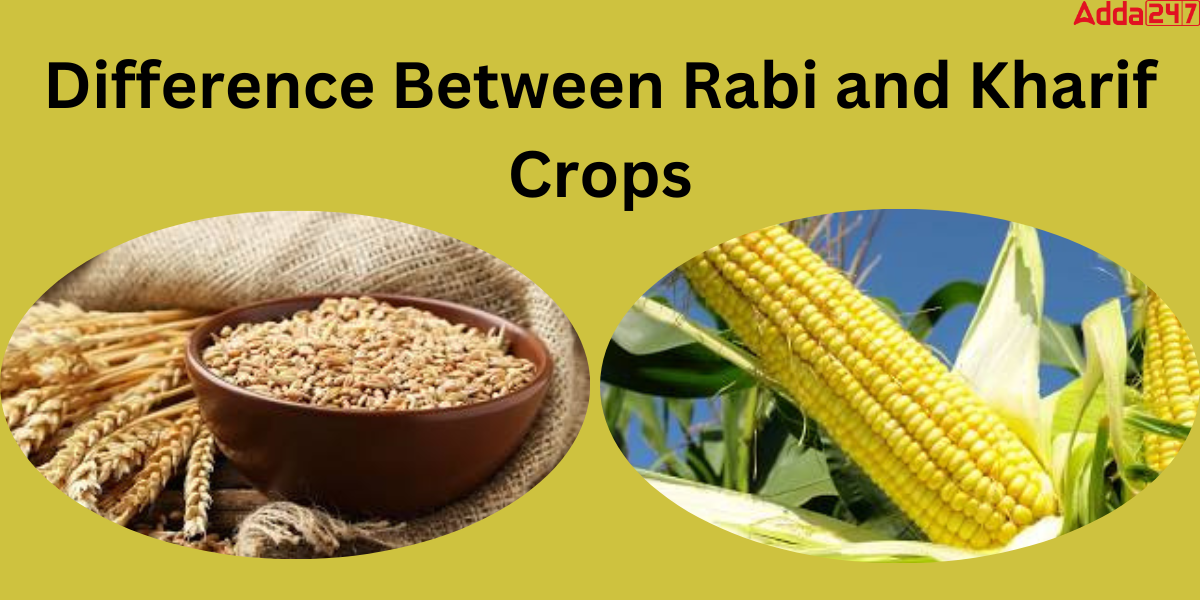Crops are plants that are cultivated and farmed by people for a variety of reasons, including food, fiber, medicine, and ornamentation. But not all crops grow in the same season. Different crops have different needs and require different climatic conditions. Kharif and Rabi are two agricultural patterns used by many Asian countries according to the monsoon. What is the difference Between Rabi and Kharif Crops is one of the most common Questions in the Class 9 Geography. Exams. In this article, we are going to know the differences Between Rabi and Kharif Crops in detail.
Difference Between Rabi and Kharif Crops
Crops in India are primarily grouped into two categories based on their growing seasons: Kharif Crops and Rabi Crops. This classification aids in agricultural activity and resource management planning based on water availability and meteorological conditions throughout these two separate seasons. The Main Difference between Rabi and Kharif Crops is that Rabi crops are sown in the winter from October to December and harvested from April to June. Before going into the difference Between Rabi and Kharif Crops, we have a brief Idea of the Rabi and Kharif Crops.
Rabi Crops Definition
The term ‘Rabi’ comes from the Arabic language. It means ‘Spring’ in English. Rabi crops are sown in India and Pakistan throughout the winter, which is why they are also known as winter crops. The sowing season of Rabi Crops often begins in October or November. The crops are harvested between March and April when the region is in full bloom. Because the monsoon season in these nations ends in November, these crops are typically grown with irrigation or rainfall that has percolated into the ground.
Examples of Rabi crops:
Major Rabi crops grown in India include
- Wheat
- Oats
- Linseed
- Pulses
- Barley
- Mustard
Kharif Crops Definition
Kharif is an Arabic term that signifies ‘autumn’.The Kharif farming season begins with the arrival of the monsoon in the Indian subcontinent. As a result, Kharif crops are often sown around the start of the first monsoon rains. These crops are also known as monsoon crops because they are cultivated during this season.
The Kharif season, on the other hand, varies from state to state within India. In different parts of India, the sowing season varies according to the arrival of the monsoon. Kharif crops are typically harvested in September or October. The amount and time of rainfall are the two most important factors influencing Kharif crop growth. They thrive in rain-fed locations with hot, humid weather. Kharif crops rely heavily on rainfall patterns.
Examples of Kharif crops
Major Kharif crops grown in India include
- Rice
- Cotton
- Maize
- Bajra
- Sorghum
- Soybean
Difference between Rabi and Kharif Crops
Rabi and Kharif are separate farming seasons in India that are determined by monsoon patterns and weather conditions. The primary difference between Rabi and Kharif crops is in their planting and harvesting times, which are determined by the season’s temperature, water, and moisture requirements. Go through the table below to get a clear overview of the fundamental differences between Rabi Crops and Kharif Crops.
| Difference between Rabi and Kharif crops | ||
| Point of Differences | Rabi crops | Kharif crops |
| Sowing Season | Rabi crops are sown in the winter between October to December., preferably after the monsoon rains. | Kharif crops are sown in between June and July, usually at the start of the first monsoon rains. |
| Harvesting Season | These crops are harvested between the months of April and June. | These crops are harvested between September and October. |
| Etymology | “Rabi” means “spring season” in Arabic. | “Kharif” means “autumn season” in Arabic. |
| Also Known As | Winter crops | Monsoon crops/ Autumn Crops |
| Rainfall dependency | These crops are less dependent on rain, which sometimes rains in winter badly affects rabi crops | These crops depend largely on monsoon rains.- Inadequate or excessive rainfall can derail attempts. |
| Climate Required | They require cold temperatures to grow and worm environment to seed germination; however, worm climate has a negative impact on germination and yield. | They need a lot of rain and a hot temperature to develop and germinate. The hot climate has little effect on seed germination or growth. |
| Rainfall pattern | Rabi crops can be destroyed by heavy/good winter rain. As water irrigation systems are employed for harvesting, these crops are not affected by rainfall patterns. | Heavy/good rainfall is required. If there is insufficient rainfall, crops impacted by this/drought conditions may be destroyed. |
| Flowering | Flowering needs a longer day length | Flowering needs a Shorter day length |
| Weather Condition | Rabi crops flourish best in dry conditions. | Kharif crops flourish in humid climates. |
| Major Crops | Wheat, oats, mustard, chickpea, barley, pulses, linseed, etc | Maize, rice, cotton, sorghum bajra, etc |
| States | Madhya Pradesh, Odisha, Haryana, Uttar Pradesh, Punjab and Rajasthan. | Kerala, Punjab, Haryana, and Tamil Nadu |









 CBSE Date Sheet 2026 for Class 10 & ...
CBSE Date Sheet 2026 for Class 10 & ...
 CBSE Class 10 Date Sheet 2026, Check 10t...
CBSE Class 10 Date Sheet 2026, Check 10t...
 CUET History Syllabus 2026 (Updated), Do...
CUET History Syllabus 2026 (Updated), Do...














